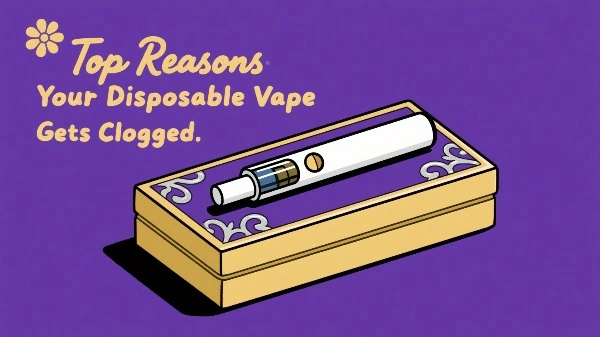Table of Contents
ToggleHave you ever been enjoying your disposable vape when suddenly the draw feels tight or the vapor weakens? This happens because condensation, cold e-liquid, or rapid puffing can block the airflow. In this quick guide, you’ll learn the most common reasons disposable vapes clog and how to fix and prevent blockages safely in 2025. Before fixing, it’s useful to understand how disposable vapes actually work and differ from refillable ones.
A clogged vape is caused by a blockage in the airway. The most common causes are: build-up of condensation, high e-liquid viscosity (thickness), incorrect storage, and incorrect puffing techniques. These issues can range from slightly affecting the flavour to rendering the device unusable, so it’s crucial to understand how to address them scientifically. If your vape completely stops working after clogging, follow this troubleshooting guide for non-responsive pens.
Top 10 Reasons Your Disposable Vape Gets Clogged and How to Fix Them
1. Condensate Buildup: Why Your Disposable Vape Clogs Silently
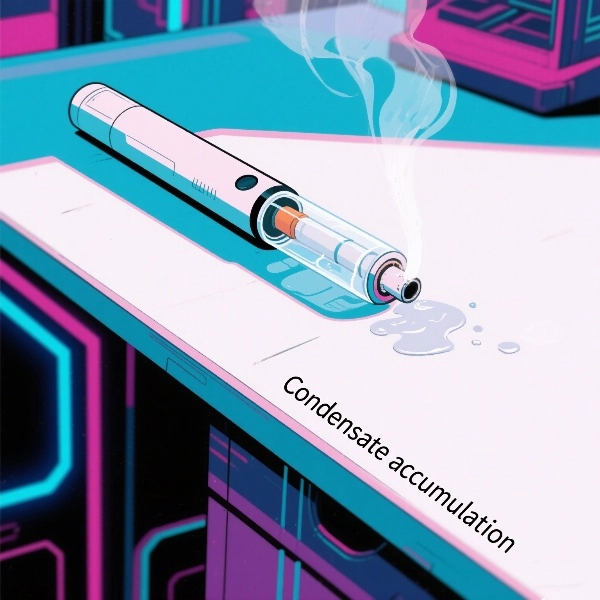
Are you struggling with a tight draw or weak vapor? Condensate remains the primary cause of disposable vape clogs, accounting for 40% of blockages reported by users. This sticky liquid forms when unevaporated e-liquid cools in the airway. It is often the cause of problems. If you don’t clean it, it can build up and become like limescale. This can narrow the airflow and make the device feel like it’s not working well.
Common Mistakes:
- Neglecting storage: If you store your vape horizontally, the liquid can mix with the leftover e-liquid, turning into hard lumps.
- Using after long idle: If you use a device that has been left dormant for a while without cleaning it first, old condensate can block the airway.
Quick Fixes:
- Centrifugal Shake: Wrap the mouthpiece in tissue, hold it vertically, and give it 5–8 sharp downward shakes to get rid of any liquid that has collected inside.
- Warm Water Soak: Put the mouthpiece in 40°C water for 30 seconds to melt any thickened residue, then take it out and shake it dry.
- Gentle Swabbing: Use a cotton swab soaked in alcohol to gently clean the inside of the airway. This will remove any sticky gunk without scratching the surface.
Prevention Tips:
- Post-use shake: After each session, shake the bottle lightly (3-5 times) to get rid of any extra liquid.
- Upright storage: Use a stand to keep the device upright to stop water from building up on the mouthpiece.
- Weekly hygiene: Make sure you clean the mouthpiece with alcohol wipes to stop bacteria from building up.
- PG-rich e-liquid: Choose blends with more propylene glycol (PG)—they are less likely to collect water droplets than high-VG options.
2. High-Viscosity E-Liquid: How Cold Temperatures Clog Your Vape
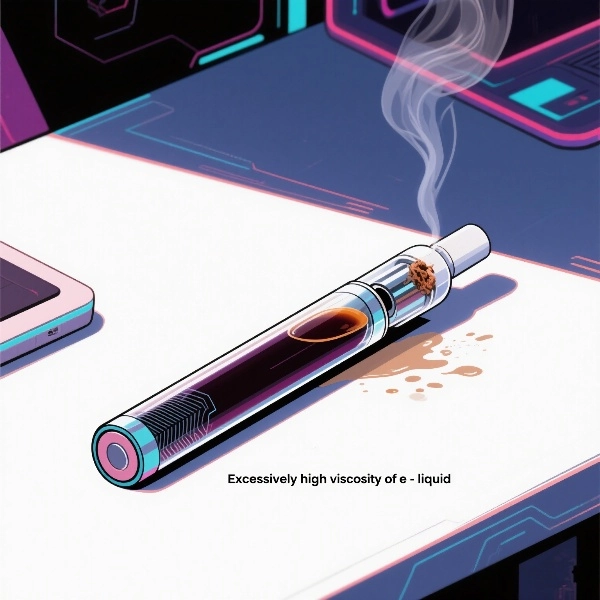
Do you find it hard to breathe when it’s cold outside? At temperatures below 10 °C, high-VG liquids thicken and triple the risk of clogging. Thick VG can’t wick fast enough, leaving residue and dry burns. For detailed ingredient behaviour at different VG/PG ratios, see our guide to vape juice composition.
Pitfalls to Avoid:
- Exposed storage: Don’t leave vapes in the car’s glovebox or outer pocket, where it’s too hot for the liquid to melt.
- Extreme cloud-chasing: Choosing e-liquids with 90% VG without thinking about the impact of temperature on how easily they flow.
Emergency Solutions:
- Body Heat Warm-Up: Hold the device mouthpiece down in your palm for two minutes to soften the thickened liquid using your body’s natural 37°C temperature.
- Warm Towel Wrap: Cover the device in a damp paper towel (avoid the charging ports), leave it for three minutes, then shake it to remove any remaining soft residue.
- Room Thaw: If you store it in the fridge, let it sit at room temperature for 10–15 minutes to get back to normal.
Seasonal Tips:
- Balanced blends: In winter, use a 60/40 VG/PG ratio for best atomisation and flow.
- Insulated carry: Keep it in a pouch or pocket that is lined with fleece to keep it warm.
- Pre-use preheat: Make the device warm by holding it close to your chest for 10 minutes before vaping in very cold conditions.
3. Rapid Puffing: How It Causes Clogs and Pressure Imbalance
If you breathe too quickly, you can create a vacuum inside the device. It’s like sucking a straw too fast. This makes the e-liquid enter the coil more quickly than it can turn into vapor, which can lead to pooling and unstable airflow. It’s like flooring the gas pedal in a car, which puts too much pressure on the engine. For guidance on proper inhalation technique and first-time use, read our beginner’s manual.
Best Practices:
- Mindful inhaling: Taking 2–3 second draws with 10-second pauses can prevent pressure-induced clogs caused by chain vaping, a leading culprit in 30% of clog-related repairs.
- Puff intervals: Wait 10+ seconds between each inhalation to let the pressure go down and the e-liquid redistribute.
Clog Buster:
If you have a mild blockage, try the pulse draw technique: 2–3 quick 0.5-second inhales to break the vacuum, then pause for 5 seconds before continuing to vape to restore smooth airflow.
4. Low Battery: The Clog Accelerator
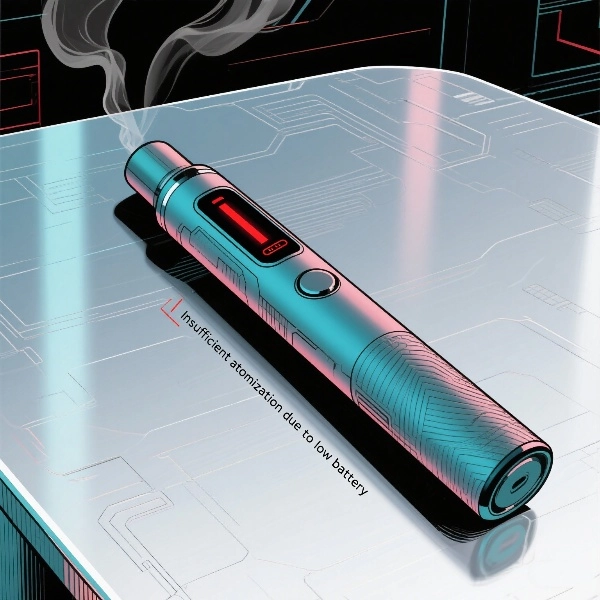
Do you notice that your battery is running low when you use it? If the voltage is below 3.3V, the coil cannot reach the optimal temperature (200–250°C), which means that the e-liquid is only partially vaporised. This creates a sticky residue that can block the wick. If the battery is less than 30% charged, there is a 50% higher chance of it catching fire, and the voltage can become unstable, creating harmful byproducts. If your vape charges slowly or shows no light, check this charging guide for best practices. See CPSC’s Lithium-Ion Battery Safety Center for verified charging precautions.
Emergency Power Boosts:
- Short charge fix: Connect to a 5V/1A power bank for three minutes (check that it can fast-charge first).
- Button reset: Click the power button 10 times quickly (on models that have one) to temporarily increase the voltage.
- Reverse draw (refillable only): Breathe gently through the refill port. This will help to move any e-liquid that has not been absorbed and clear any small blockages.
Battery Care:
- Charge early: Make sure you plug it in when it’s 20% charged. This will help to stop the battery from going too low and causing problems.
- Smart device choice: Choose models that show the battery level or that can be charged quickly using a Type-C cable.
- Port maintenance: Clean charging contacts should be cleaned every month with a dry cloth to remove oxidation.
5. Design Flaw: The Too-Narrow Airflow Hole
Even a vape that’s been cleaned and charged can feel “choked” because of a tiny hole in the airflow (less than 1.2mm). Narrow holes create a Venturi effect, which speeds up air and forms a vacuum around the coil that traps e-liquid. This “airlock” needs 2–3 times more suction, which makes condensation build up.
Risks of DIY Mods:
Widening holes with tools like toothpicks can:
- This can cause damage to the internal seals, which can lead to leaks or short circuits.
- Make the guarantees invalid.
- The airflow is not as good.
Pro Advice: Replace your old devices with ones that have two airflow holes and air channels. These are designed to make it easy to draw.
6. Cold Weather: The Viscosity Villain
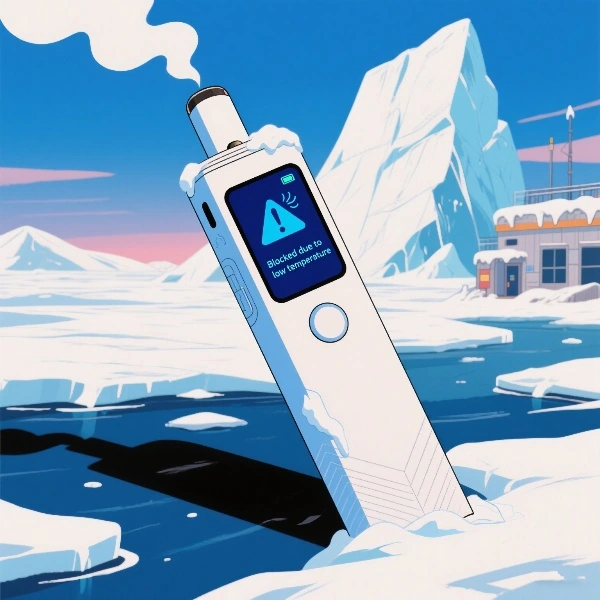
Low temperatures make e-liquid thicker, especially high-VG ones, and this can make it take longer to reach the coil. To combat this:
- Body heat insulation: Make sure you carry the vape in an inner pocket to keep it at 37°C and make the liquid stay liquid.
- Pre-use warm-up: Hold the device in your hand for 1–2 minutes before use in the cold to soften the e-liquid.
- Limit cold exposure: Never leave vapes in unheated cars or bags, as this can cause clogs.
7. Overfilling: When More Isn’t Better
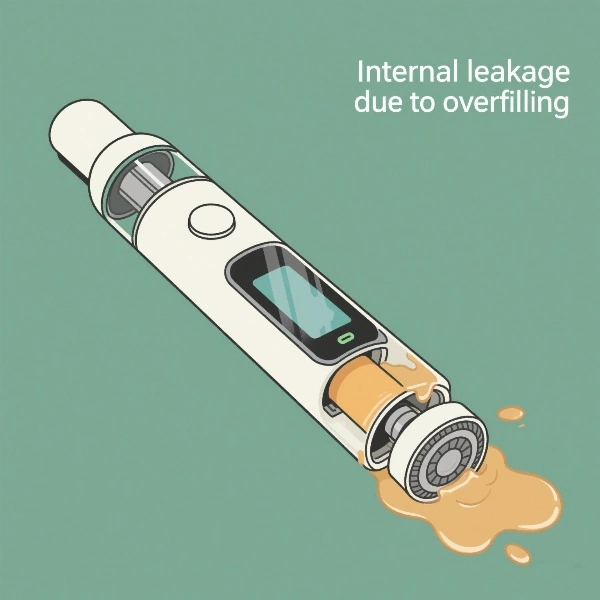
If you fill your e-liquid bottle more than 15% full, you can damage the device. This is because the e-liquid can get into the oil-locking system. If you tilt it, liquid can leak into the airway and block the mouthpiece.
Leak Response:
- Keep receipts: This is important for warranty claims.
- Know return policies: Most brands accept faulty devices, even ones that have been opened, because of problems with how they were made.
- Safety first: Stop using it right away if it starts leaking and overheating. This could cause an electrical short.
Quality check: Look for manufacturers who are certified to ISO 9001 to reduce the risk of overfilling.
8. Overusing a Depleted Device: The Dry-Burn Danger
Public Health England (PHE) has found that vaping is at least 95% less harmful than smoking. When used normally, formaldehyde emissions are very low. But if you vape continuously until the e-liquid is all gone, it can cause dry burning. Lab tests have shown that some harmful substances (like aldehydes) can increase by about 30 times compared to normal use.
When to Retire:
- The coil has lost its colour and looks brown or black because of a build-up of carbon.
- The e-liquid window is empty, or the low-battery light is flashing.
- Something might taste a bit burnt, or you might notice that something is a bit warm to the touch.
Lifespan Hack:
Track puffs (average 300 per device) and wait 15 seconds between each inhalation to avoid overworking the coil. Safety is more important than getting the last puffs out.
9. Mouthpiece Contamination: The Lint and Bacteria Trap
That white fuzz inside your mouthpiece? It’s lint from pockets, which, when combined with condensation, forms a biofilm. Lab tests have shown that uncleaned mouthpieces harbour 3 times more bacteria than toilet seats.
Hygiene Routine:
- Tools: A soft microfibre cloth and tapered cleaning sticks (which won’t shed).
- Step-by-step:
- Wipe off any dirt or debris from the outside of the object using a dry cloth.
- Use isopropyl alcohol to clean the inside and get rid of any fluff and bacteria.
- Let it dry completely in the air so that the metal doesn’t rust.
Cleaning caution: Avoid using cleaners that contain chlorine, as these can damage the components, or forcing tools into narrow airways.
10. Coil-E-Liquid Mismatch: The Compatibility Crisis
If you use the wrong e-liquid for your coil type, it will not work well:
- Ceramic coils (high-VG, 60 %+): Get perfect even heating for thick vapor (e.g., Cosmic Fog, Vapetasia).
- Cotton coils (high-PG, 50 %+): Offer a product that will quickly remove sweat and give a strong flavour (for example, Halo or Black Note).
Pro Tip:
Check the packaging to see what type of coil you need (e.g., “mesh coil”). If you use a coil that is not the right type (e.g., high-VG in cotton coils), it can cause slow wicking, dry burns, and rapid clogs.
Final Takeaway
By fixing these 10 things, from how users behave to design problems, you can make vaping better. If you want every drag to be smooth, flavourful, and safe, you need to do three things: clean your vape regularly, store it properly, and take care when you use it. It’s better to stop vaping before you get frustrated.
How to Fix a Clogged Disposable Vape Fast: 4 Simple Steps
1. Physical Liquid Drainage
Action: Hold the vape upside down and tap the bottom 5 times, but not too hard.
Why it works: It uses gravity and small vibrations to remove condensation or e-liquid residue from the airway, which helps to keep the air flowing smoothly.
2. Mouthpiece Debris Removal
Tools: You will need a straightened paperclip or toothpick (but be very careful!).
Steps:
- Gently put the tool into the mouthpiece and turn it to remove any stuck-on bits.
- Clear any lumps of e-liquid, fluff, or dust that are blocking the airway.
- Caution: Don’t use too much force to stop you damaging the inside of the machine.
3. Air Pressure Equalization
Method:
- First, you need to take the mouthpiece off the device.
- Let the vape sit uncovered for 10 minutes to balance the air pressure inside.
- Science: This means that if there is a blockage caused by a build-up of pressure, the e-liquid can drain back into the reservoir, reducing the risk of blockages.
4. Advanced Solutions for Stubborn Clogs
If the blockages don’t go away, try these heat-based techniques (be careful!):
Step 1: Low-Temperature Airflow
- Set your hairdryer to low heat (high heat damages hair, so avoid it).
- Point the airflow at the bottom vent for 10–15 seconds to soften the thickened e-liquid.
Step 2: Warm Water Softening (for sealed devices)
- Put the vape in a sealed plastic bag that is sealed. This will stop it from getting wet.
- Put it in water that is not too hot and not too cold (around 40–50°C) and leave it there for five minutes. This is best for clogs caused by high-VG e-liquid thickening in cold temperatures.
Step 3: Post-Heat Testing
- Make sure the device is completely dry after heating it.
- Take a deep breath to check if there is still air coming through. If not, the blockage may be permanent.
Critical Safety Reminders
- Limit heating time: Don’t use heat for more than 15 seconds without resting for 15 seconds. This will stop the coil or battery from getting damaged.
- Protect electrical components: Make sure there is no water in the charge port or battery compartment when you are cleaning or heating them.
- Know when to replace: You can’t repair disposable vapes. If your drain often gets blocked, it’s probably time to get a new one.
If you do this, you should be able to fix most blockages quickly and easily. To keep it working well, make sure you clean it regularly and store it properly (keep it upright and avoid extreme temperatures).
5 Maintenance Habits to Prevent Disposable Vape Clogs & Extend Lifespan
1. Daily Maintenance: Keep Connections Clean
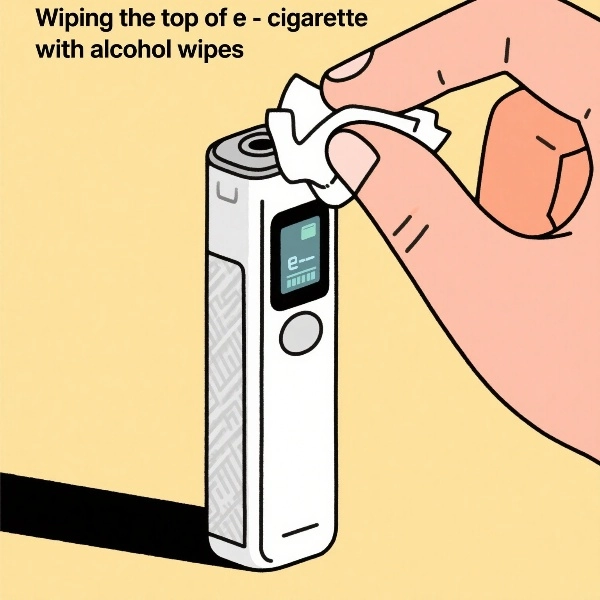
Action: Wipe the device’s battery contacts and threaded parts every week with alcohol wipes.
Why it matters: It removes e-liquid residue, dust, and oxidation, which can disrupt electrical connections. A clean interface makes sure there’s always enough power, so you won’t get any performance drops or unexpected shutdowns.
2. Moderate Usage: Limit Daily Puff Count
Guideline: Don’t use more than 300 puffs a day.
Benefits: If you breathe out gently (in a moderate way), you will reduce the stress on the coil and wick. This will stop them from wearing out. Studies show that if you use it in the right way, you can reduce the risk of clogs and dry burns. This means your food will taste better and your device will last longer.
3. Storage Practices: Always Store Upright
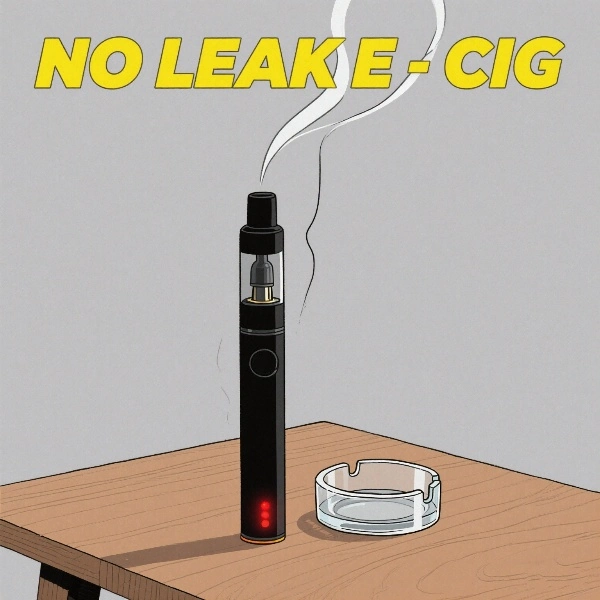
Make sure you always stand the vape vertically. Never lay it horizontally.
Science behind it:
- This stops e-liquid from getting into the airflow system, which reduces leaks and coil flooding.
- Reduces the build-up of moisture in the mouthpiece or airway, which often causes blockages.
- Pro tip: To help you keep up this habit, use a special stand or keep it upright in a pocket.
4. Environmental Care: Avoid Extreme Conditions
Risky environments to avoid:
- High heat (e.g., direct sunlight, car dashboards): It can make the battery run out faster, bend plastic parts, or leak e-liquid.
- Humid spaces (e.g., bathrooms, damp bags): This can cause condensation inside the device, which can damage the electrical components over time. Ideal storage: Keep the vape in a cool, dry place (20–25°C, <60% humidity). Do not keep it near heat sources (e.g., radiators, stoves) or moisture.
5. Regular Inspections and Timely Replacement
Signs it’s time to stop using your vape:
- Persistent clogs after three cleanings: If airflow is still restricted even after cleaning (e.g., shaking or swabbing), the wick or coil is probably damaged beyond repair.
- Swelling or deformation of the casing: If the battery is bulging or the body is warped, there are internal faults. Stop using the product immediately to avoid safety hazards (e.g., leaks, short circuits).
- Darkened e-liquid or burnt taste: It shows that the coil has become carbonised, which is when charred residue builds up. This can harm the flavour and release harmful chemicals.
- Proactive replacement: Don’t wait until it’s completely broken. Replace the device as soon as you see any kind of irreversible damage, to keep things safe and working well.
If you focus on the e-liquid you choose, how much you inhale, and how you store your vape, you can make your disposable vape last 42% longer:
- Match your e-liquid: For ceramic coils, use VG ≥ 70% (smooth vapor) and for cotton coils, use PG ≥ 50% (bold throat hits).
- Puff wisely: Keep your draws to 2-3 seconds and don’t use more than 300 puffs a day to stop damage to the coil.
- Store & maintain: Make sure you stand it upright, keep it away from heat and humidity, and clean the connections once a week with alcohol wipes.
- Beat the cold: It will feel warm in your hand and will help to stop cold air from clogging up by 80%.
- Fix clogs fast: For mild clogs, tap upside down; for stubborn ones, try a water bath at 40°C for three minutes.
- Stay safe: Replace it straight away if the device swells, the e-liquid darkens, or the blockages don’t go away after cleaning it three times.
Scientific Care cuts clogs by 65%, stabilises vapour by 73%, and reduces harmful dry burns. Enjoy smoother, longer-lasting vaping!
FAQ
If I inhale strongly, will this clear my vape?
Using a bit more suction might help with mild blockages, but using too much force can pull e-liquid into the airway too quickly, which can make blockages worse or burn the coil. For safer, more effective results (the success rate is 65% higher), try tapping the device upside down and gently cleaning the mouthpiece with a toothpick first.
Does putting it in the fridge stop it from leaking?
No—low temperatures (like those found in refrigerators) can make e-liquid solid and shrink sealing silicone, which can cause leakage. Store it upright in a cool, dry place (15–25°C) away from direct sunlight or heat.
Is it safe to use a needle to clear the mouthpiece?
Be careful! A needle can pierce the airway or coil, causing permanent damage. Instead, use a toothpick wrapped in an alcohol wipe. Gently rotate the wipe to clean the inside of the mouthpiece. This will disinfect it without causing any harm.
